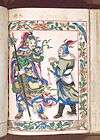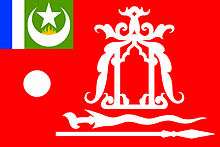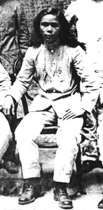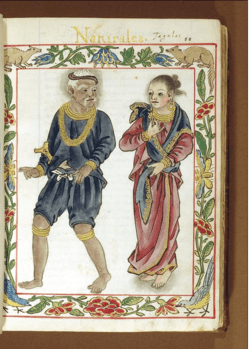List of sovereign state leaders in the Philippines
| Maginoo, Huangs, Lakans, Kadatuan and Sultanates of Philippines | |
|---|---|
 | |
|
A couple belong in maharlika (Noble class). | |
| Details | |
| Style |
Maharlika Kamahalan Kapunuan |
| First monarch | Jayadewa (and other various Rulers from the archipelago) |
| Last monarch | Raja Sulayman(and other various Rulers from the archipelago) |
| Formation |
c. 900–1000 (According to LCI). |
| Abolition | 1600 (due to Spanish Conquest). |
| Residence | Torogan |
| Appointer | Shaman |
| Pretender(s) | 'various |
The types of sovereign state leaders in the Philippine archipelago have varied throughout the country's history, from heads of ancient chiefdoms, kingdoms and sultanates in the pre-colonial period, to leaders of Spanish, American, and Japanese colonial governments, until the directly-elected President of the modern sovereign state of the Philippines.
Pre colonial epoch
The rulers the many pre-Hispanic states and chiefdoms in what is now the Philippines are based on the oral traditions and written accounts of the Chinese and Spanish accounts.
Huangdom of Ma-i State
| Name | Image | Title held | From | Until |
|---|---|---|---|---|
| Gat Sa Li-han |  | "王" Huang (King) according to Chinese records | 1225? | ? |
Huangdom of Pangasinan (Luyag na Kaboloan)
| Ruler | Image | Events | From | Until |
|---|---|---|---|---|
| Kamayin (細馬銀) | Tribute of silver and horses to China | 1406 | 1408 | |
| Taymey | Embassy to China formally established | 1408 | 1409 | |
| Liyu | 1409 | ? | ||
| Yongle Emperor (Honorary) |  | Chinese Emperor holds a banquet in honor of Pangasinan | December 11, 1411 | |
| Warrior-Princess Udaya | The Huangdom enjoys prosperity | 1500s | ||
| Chinese Warlord Limahong | Pangasinan is sacked and a pirate-enclave is established | 1575 | ||
| Conquistador Juan de Salcedo | Pirates were repulsed and Pangasinan is incorporated into the Spanish Empire | 1575-1576 | ||
Lagendary Rulers
- Legendary rulers can be found in the oral tradition in Philippine Mythology, which having a uncertain historical /archeological evidence of their reign.
| Image | Name | Title held | From | Until |
|---|---|---|---|---|
| Ama-ron | Like most of the male Filipino mythological heroes, he is described as an attractive well-built man who exemplifies great strength. Ama-ron is unique among other Filipino legends due to the lack of having a story on how he was born which was common with Filipino epic heroes. | Uncertain possibly Iron Age. | ||
| Gat Pangil | Gat Pangil was a chieftain in the area now known as Laguna Province, He is mentioned in the origin legends of Bay, Laguna,Pangil, Laguna, Pakil, Laguna and Mauban, Quezon, all of which are thought to have once been under his domain. | Uncertain possibly Iron Age. |
Historical Rulers of Tondo
| Image | Name | Title held | From | Until |
|---|---|---|---|---|
| Jayadeva | Senapati (Admiral) (Known only in the LCI as the King who give the pardon to Lord Namwaran and his wife Dayang Agkatan and their daughter named Bukah for their excessive debts in 900 AD.) | 900? | ? | |
| Lakan Timamanukum | Father of Rajah Alon, he ruled when Tondo become a fortified Mandala at the mouth of Pasig River. | 1150? | ? | |
| Alon | Lakan Alon (Son of Timamanukum, he expanded the Tondo territory from Ilocandia to Bicolandia.) | 1200? | ? | |
| Gambang | Lakan Gambang another ruler who used the title Senapati or Admiral. | 1390? | 1417? | |
| Suko | Lakan Suko (or also known as Sukwu (朔霧) means "northern mist" , According to the Dongxi Yanggao (東西洋考) Abdicated .) | 1417? | 1430? | |
| Lontok | Lakan Lontok (later converted his faith to Islam). | 1430? | 1450? | |
| Kalangitan | Dayang Kaylangitan, Queen of Namayan and Tondo. (the only recorded queen regnant of the pre-Hispanic Philippine Kingdom of Tondo. The eldest daughter of Rajah Gambang and co-regent with her husband, Rajah Lontok, she is considered one of the most powerful rulers in the kingdom's history.) | 1450? | 1515? | |
| Salalila | Rajah Salalila or Rajah Sulayman I (A puppet Rajah installed by Sultan Bolkiah .) | 1515? | 1558? | |
| Matanda | Rajah Matanda or Rajah Sulayman II or Rajah Ache, King of Namayan | 1558? | 1571 | |
| Lakan Dula | Banaw Lakandula, King of Tondo and Sabag | 1558? | 1571 | |
| Sulayman | Rajah Sulayman, King of Tondo | 1571 | 1585 | |
| Magat Salamat | The last ruler of Tondo dynasty after the monarchy is dissolved by the Spanish authorities after he leads the Tondo conspiracy. | 1575 | 1587 |
| Pre-hispanic History of the Philippines |
 |
|---|
| Barangay government |
| Ten datus of Borneo |
| States in Luzon |
| Luyag na Kaboloan (Pangasinan) |
| Ma-i |
| Kingdom of Maynila |
| Namayan |
| Kingdom of Tondo |
| States in the Visayas |
| Kedatuan of Madja-as |
| Rajahnate of Cebu |
| States in Mindanao |
| Rajahnate of Butuan |
| Sultanate of Sulu |
| Sultanate of Maguindanao |
| Sultanate of Lanao |
| Key figures |
| Sulaiman II · Lakan Dula · Sulaiman III · Katuna |
| Tarik Sulayman · Tupas · Kabungsuwan · Kudarat |
| Humabon · Lapu-Lapu · Alimuddin I · Muedzul Lail Tan Kiram |
| History of the Philippines |
| Portal: Philippines |
The Datus of Madja-as
| Commander-In-Chief | Image | Capital | From | Until |
|---|---|---|---|---|
| Datu Puti | Aklan | 13th century | 1212 | |
| Datu Sumakwel | Malandong (today in Antique) | 1213 | ? | |
| Datu Bangkaya | Aklan | ? | ? | |
| Datu Paiburong | Irong-Irong | ? | ? | |
| Datu Balengkaka | Aklan | ? | ? | |
| Datu Kalantiaw | Batan | 1365 | 1437 | |
| Datu Manduyog | Batkcan | 1437 | ? | |
| Datu Padojinog | Irong-Irong, now Iloilo | ? | ? | |
| Datu Kabnayag | Kalibo | ? | 1565 | |
| Datu Lubay | San Joaquín | ? | ? |
Rulers of the Maynila
| Name | From | Until |
|---|---|---|
| Sultan Bolkiah | 1500 | 1571 |
| Rajah Sulayman | 1571 | 1585 |
Monarchs of the Butuan Rajahnate
| The Royal Title of the Reigning Rajah | Image | Events | From | Until |
|---|---|---|---|---|
| Rajah Kiling | The Embassy of I-shu-han (李竾罕) | 989 | 1009 | |
| Sri Bata Shaja | Mission by Likanhsieh (李于燮) | 1011 | ? | |
| Rajah Siagu | Annexation by Ferdinand Magellan | ? | 1521 | |
Raja's of Cebu
| The Royal Title of the Reigning Rajah | Image | Events | From | Until |
|---|---|---|---|---|
| Sri Lumay | ? | |||
| Rajah Humabon | Annexation by Ferdinand Magellan | ? | ||
| Rajah Tupas | Spanish Period | |||
Sultans of Maguindanao
| Reign | Sultan | Other name(s) | |
|---|---|---|---|
| 1520–1543 | Shariff Kabungsuwan | A Johore (Singapore) Makdum Prince who fled to Malabang Lanao and seated as Sharif Kabungsuwan. Married the daughter of Chieftain Aliwya of the Maguindanao family clan at Dulawan, Cotabato. Took over the father inlaw's political powers establishing the Sultanate of Maguindanao later called by the Spanish as Mindanao. He is the second Makdum known as Karim Ul-Makdum who reinforced Islam and His brother Sulu Sultan Shariful Hashim promulgated Kor'anic studies or Madrassahs.
The said Sharif is buried at Simunul Island Tamppat. | |
| 1543–1574 | Sultan Maka-alang Saripada | ||
| 1574–1578 | Sultan Bangkaya | ||
| 1578–1585 | Sultan Dimasangcay Adel | ||
| 1585–1597 | Sultan Gugu Sarikula | Datu Salikala | |
| 1597–1619 | Sultan Laut Buisan | Datu Katchil | |
| 1619–1671? | Sultan Muhammad Dipatuan Kudarat | Datu Qudratullah Katchil | |
| 1671?–1678? | Sultan Dundang Tidulay | Sultan Saif ud-Din (Saifud Din) | |
| 1678?–1699 | Sultan Barahaman | Sultan Muhammad Shah Minulu-sa-Rahmatullah | |
| 1699–1702 | Sultan Kahar ud-Din Kuda | Maulana Amir ul-Umara Jamal ul-Azam | |
| 1702–1736 | Sultan Bayan ul-Anwar { Maruhom Batua } | Dipatuan Jalal ud-Din Mupat Batua (posthumously) | |
| 1710–1736 (in Tamontaka) | Sultan Amir ud-Din | Paduka Sri Sultan Muhammad Jafar Sadiq Manamir Shahid Mupat (posthumously) | |
| 1736–1748 (in Sibugay, Buayan, Malabang) | Sultan Muhammad Tahir ud-Din | Dipatuan Malinug Muhammad Shah Amir ud-Din | |
| 1733–1755 (paramount chief of Maguindanao by 1748) | Sultan Rajah Muda Muhammad Khair ud-Din | Pakir Maulana Kamsa Amir ud-Din Itamza Azim ud-Din Amir ul-M'umimin | |
| 1755–1780? | Sultan Pahar ud-Din | Datu Panglu/Pongloc Mupat Hidayat (posthumously) | |
| 1780?–1805? | Sultan Kibad Sahriyal | Muhammad Azim ud-Din Amir ul-Umara | |
| 1805?–1830? | Sultan Kawasa Anwar ud-Din | Muhammad Amir ul-Umara Iskandar Jukarnain | |
| 1830–1854 | Sultan Qudratullah Untung | Iskandar Qudratullah Muhammad Jamal ul-Azam Iskandar Qudarat Pahar ud-Din. Properly place, his name was Ullah Untong and seated as Sultan Ashrf Samalan Farid Quadratullah or better known as Sultan Qudarat. www.royalsultanate.weebly.com | |
| 1854–1884 | Sultan Muhammad Makakwa | ||
| 1884–1888 | Sultan Wata | Sultan Muhammad Jalal ud-Din Pablu | |
| 1888–1896 | No sultan Sultan Anwar ud-Din contested Datu Mamaku (son of Sultan Qudratullah Untung) of Buayan for the throne versus the then sultan Datu Mangigin of Sibugay. | ||
| 1896–1898 | Sultan Taha Colo | Sultan Rabago sa Tiguma | |
| 1908-1933 | Sultan Mastura Kudarat | Sultan Muhammad Hijaban Iskandar Mastura Kudarat, Sultan Mastura | |
The Sultans of Sulu (1405–present)
| Sultans | Image | From | Until |
|---|---|---|---|
| Sharif ul-Hashim of Sulu |  | 1480 | 1505 |
| Sultan Kamalud-Din |  | 1505 | 1527 |
| Sultan Amirul-Umara |  | 1893 | 1899 |
| Jamal ul-Kiram I |  | 1893 | 1899 |
| Mahakuttah Kiram |  | 1974 | 1986 |
| Muedzul Lail Tan Kiram |  | 1986 | |
Rulers during the Spanish colonization
- Rajah Colambu – King of Limasawa in 1521, brother of Rajah Siagu of Butuan. He befriended Portuguese explorer Ferdinand Magellan and guided him to Cebu on April 7, 1521.
- Rajah Humabon – King of Cebu who became an ally of Ferdinand Magellan and the Spaniards. Rival of Datu Lapu-Lapu. In 1521, he and his wife were baptized as Christians and given Christian names Carlos and Juana after the Spanish royalty, King Carlos and Queen Juana.
- Sultan Kudarat – Sultan of Maguindanao.
- Lakan Dula or Lakandula – King of Tondo, one of the last princes of Manila.
- Datu Lapu-Lapu – King of Mactan Island. He defeated the Spaniards on April 27, 1521.
- Datu Sikatuna – King of Bohol in 1565. He made a blood compact with Spanish explorer, Miguel López de Legazpi.
- Datu Pagbuaya – King of Bohol. He governed with his brother Datu Dailisan, a settlement along the shorelines between Mansasa, Tagbilaran and Dauis, which was abandoned years before the Spanish colonization due to Portuguese and Ternatean attacks. He founded Dapitan in the northern shore of Mindanao.
- Datu Dailisan – King of Mansasa, Tagbilaran and Dauis and governed their kingdom along with his brother Datu Pagbuaya. His death during one of the Portuguese raids caused the abandonment of the settlement.
- Datu Manooc – Christian name – Pedro Manuel Manooc, son of Datu Pagbuaya who converted to Christianity, defeated the Higaonon tribe in Iligan, Mindanao. He established one of the first Christian settlements in the country.
- Datu Macabulos – King of Pampanga in 1571.
- Rajah Siagu – King of the Manobo in 1521.
- Apo Noan – Chieftain of Mandani (present day Mandaue) in 1521.
- Apo Macarere – Famous Chieftain of the Tagbanwa warrior tribe in Corong Island (Calis).
- Rajah Sulaiman III – One of the last King of Manila, was defeated by Martín de Goiti, a Spanish soldier commissioned by López de Legazpi to Manila.
- Rajah Tupas – King of Cebu, conquered by Miguel López de Legazpi.
- Datu Urduja – Female Leader in Pangasinan.
- Datu Zula – Chieftain of Mactan, Cebu. Rival of Lapu-lapu
- Datu Kalun – Ruler of the Island of the Basilan and the Yakans in Mindanao, converted his line to Christianity
- Datu Sanday – Ruler of Marawi City
- Datu Saiden Borero – King of Antique
- unnamed Datu – King of Taytay Palawan. Mentioned by Pigafetta, chronicler of Magellan. The king, together with his wife were kidnapped by the remnant troops from Magellan's fleet after fleeing Cebu to secure provisions for their crossing to the Moluccas.
- Datu Cabaylo (Cabailo) – The last king of the Kingdom of Taytay
2. Lumad Datus in Mindanao
Datu Julius Cayon
- Datu Benhur – Lumad leader of the Banuaon tribe[1]
- Datu Viloso Suhat, also known as Datu Lipatuan – a tribal leader from the Tinananon Menuvo tribe in Arakan, North Cotabato, and the first Lumad to sit in a local legislative body in central Mindanao.[2]
- Datu Lamparan Lihao Danda – a Chief Tribal leader from Subanen tribe, and a second generation descendant of Timuay Danda Antanao the oborigin of Municipality of Kabasalan, Zamboanga Sibugay. Elected Mayor of Municipality of Kabasalan, Zamboanga Sibugay year 1961–1964. He is the President of United Subanen Community Association Inc.Zamboanga Sibugay/Zamboanga Del Norte/ Zamboanga Del Sur.
- Datu Wata Eduardo Lihao Danda- a tribal leader in charge of the communication for the entire Subanen Tribe. He functioned under Datu Lamparan Lihao Danda, his elder brother.He is enlisted into World War II United States Army (USAFE) Attach in Med Det. 106INF. USA Army with rank of Corporal (CPL) and capture by Japanese in May 1942, jail in camp 78 Davao, escaped the same year re-joined 41st Division USA Army, after the Philippines liberation from Imperaial Japan Force, He integrated to Philippines Constabulary (PC). retired 1972. He is a Secretary General of United Subanen Community Association Inc.Zamboanga Sibugay/Zamboanga Del Norte/ Zamboanga Del Sur.
- Datu Labi Jose Lihao Cayon – a Chief Tribal leader of the entire Subanen tribe, after the dead of Datu Lamparan Lihao Danda, who is another Lumad leader in Sibugay. He is the 1st cousin of Datu Lamparan Lihao Danda and Datu Wata Eduardo Lihao Danda.
- Datu Labi Julius Mascarinas Cayon – board member of Zamboanga Sibugay Province And the Son of late Datu Labi JoseLihao Cayon, he is recognized as the Tribal Chieftain not just in Zamboanga Sibugay but entire Region 9 and partly in Region 10. "NCIP" - national commission on indigenous people, record section.
- Datu Lumok Imbing – 2nd cousin of Datu Laparan Lihao Danda and a tribal leader from Subanen Tribe, who leads the aborigins of the Municipality of Lapuyan, Zamaboanga Del Sur Province.
- Datu Wilborne Sanghanan Danda – a board member of Sangguniang Panlalawigan of Zamboanga Sinbugay (2000–2013), Elected Vice Mayor of Municipality of Kabasalan, Zamboanga Sibugay from year 2010–2013, He is the son of Datu Lamparan Lihao Danda.
- Datu Wilfredo Lunsayan Sunggayan – 1st Indigenous Peoples representative in local legislative councils in the Province of Zamboanga Sibugay from the provincial down to the barangay level pursuant to RA 8371, helped by Datu Wilborne Sanghanan Danda. He is the grandson of Timuay Lunsayan Tigbao of San Antonio, Nazareth and the eldest son of Timuay Langhap Pablo Nanggaya Sanggayan. He is the FIRST Indigenous Peoples Representative in the Sanggauniang Panlalawigan of the Province of Zamboanga Sibugay until October 2012. He was conferred and proclaimed Datu by Datu Labi Jose Lihao Cayon.
SUBANEN DATU IN MISAMIS OCCIDENTAL AND MALINDANG MOUNTAIN RANGE – extending to the area of Zamboanga Del Norte and Zamboanga Del Sur
The Subanen Datu in Misamis Occidental was recognized by the Philippine Government in 1935, and it was Datu Gintaawan Tumagna as the over-all Chairman of the Subanen Tribe of Misamis Occidental and Mount Malindang, with his Assistant Chairman Datu Ending. Datu Gintaawan Tumagna was succeeded by his grandson Datu Orong Tumagna Paundog under his daughter Princess Pelajia Tumagna married to Datu Tranquilino Paundog, a son of a Bornean Datu Paundog.
Datu Orong Paundog was well-known and a well loved Datu and Timuay by the Subanen Tribe in the province of Misamis Occidental and Zamboanga Del Norte.During the Marcos regime, Datu Orong Paundog served as the Liaison General of the PANAMIN in the provinces of Misamis Occidental, Zamboanga Del Norte and Zamboanga Del Sur. Until his death in the year 2000 he was the Provincial Tribal Chieftain of Misamis Occidental of the Subanen Tribe. Datu Orong Paundog was succeeded by his son Datu Edelverios "Gimbiitan" Paundog, the founder of Pegsalabuk Subanen, where it had created the Pegsalabuk Subanen Global Council and the Royal Empire Circle.
DATU GINTAAWAN TUMAGNA DATU ORONG PAUNDOG DATU EDELVERIOS "GIMBIITAN" PAUNDOG of PEGSALABUK SUBANEN GLOBAL COUNCIL and ROYAL EMPIRE CIRCLE DATU FAUSTINO PAUNDOG – SAPANG DALAGA, MISAMIS OCCIDENTAL DATU FORTUNATO PAUNDOG – SERGIO OSMEÑA SR., ZAMBOANGA DEL NORTE
DATU ENDING DATU FELIPE ENDING DATU EDWIN ENDING
Revolutionary-American period
The Ruling Leaders during Philippine Revolution
| President | Image | From | Until |
|---|---|---|---|
| Andres Bonifacio |  | 1896 | 1897 |
Presidents of the Philippines
Prime Ministers of the Philippines
Other revolutionary republics and states
Biak-na-Bato 1897
| President | Image | From | Until |
|---|---|---|---|
| Emilio Aguinaldo | .jpg) | 1897 | December 15, 1897 |
First Philippine Republic Continuation 1901-1902
| President | Image | From | Until |
|---|---|---|---|
| Emilio Aguinaldo | .jpg) | 1897 | December 15, 1897 |
| Miguel Malvar |  | 1901 | 1902 |
Tagalog Republic Continuation 1902-1906
| President | Image | From | Until |
|---|---|---|---|
| Macario Sakay |  | 1902 | 1906 |
Republic of Zamboanga 1899-1903
| President | Image | From | Until |
|---|---|---|---|
| Vicente Alvarez | 1899 | 1899 | |
| Isidro Midel | 1899 | 1901 | |
| Mariano Arquiza | 1901 | 1903 |
Negros Republic 1898-1901
| President | Image | From | Until |
|---|---|---|---|
| Aniceto Lacson | ? | 1898 | 1899 |
| Melecio Severino | 1899 | 1901 | |
See also
- President of the Philippines
- List of Unofficial Presidents of the Philippines
- Vice President of the Philippines
- List of Vice Presidents of the Philippines
- Prime Minister of the Philippines (presently defunct)
- Seal of the President of the Philippines
- List of current heads of state and government
References
- ↑ "Lumad chieftain abandons rebel movement in Agusan". Manila Bulletin. 22 April 2009.
- ↑ Lumad first to sit in council | Inquirer News
External links
- Office of the President of the Philippines
- The Presidential Museum and Library
- Philippine Heads of State Timeline at www.worldstatesmen.org


